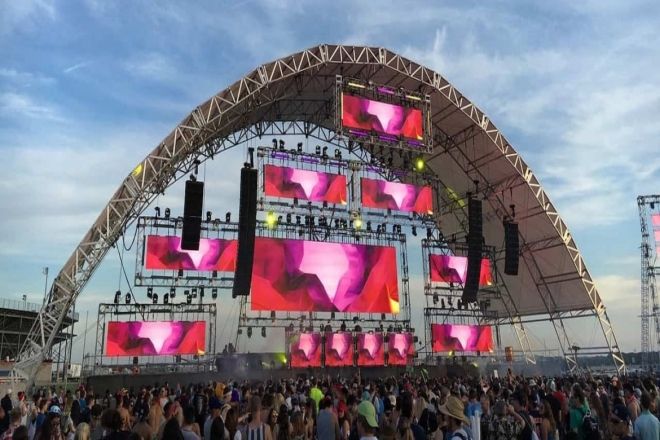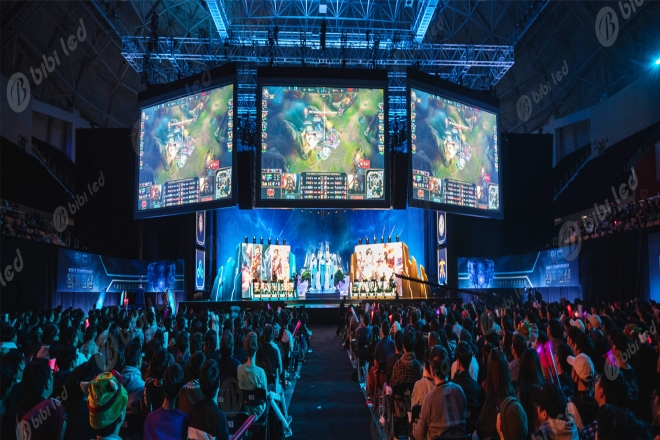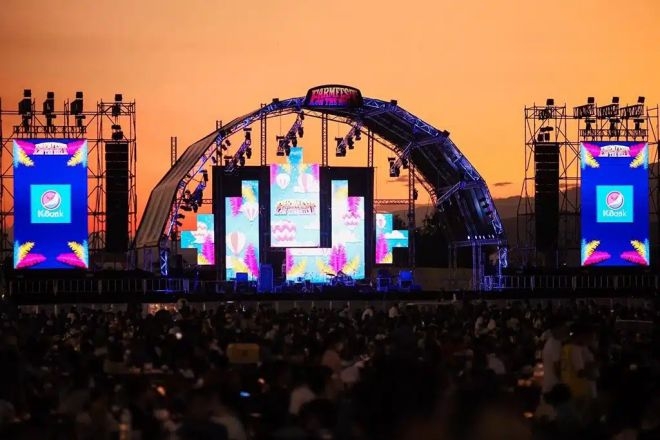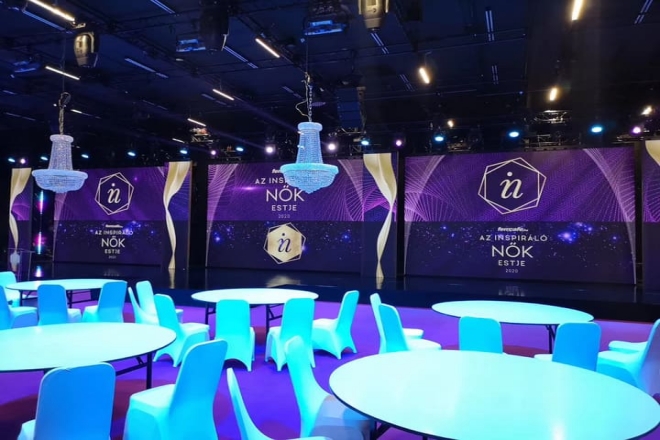Introducción

En la era digital, la forma de transmitir la información está experimentando una revolución. Como pionera de esta revolución, la tecnología de enlace multipantalla de... pantallas de visualización LED Es particularmente llamativo. No solo cambia la forma en que mostramos la información, sino que también mejora la experiencia visual del público.
Este artículo lo llevará a explorar cómo la tecnología de vinculación de múltiples pantallas de visualización LED se ha convertido en la columna vertebral de la visualización visual moderna y cómo puede crear un festín visual impactante al integrar sin problemas múltiples interfaces de visualización.
1. Tecnología de vinculación de múltiples pantallas, en pocas palabras
La vinculación de múltiples pantallas es como tener varias pantallas de TV o teléfonos móviles en casa que pueden trabajar juntas para reproducir el mismo contenido o uno diferente.
En las pantallas LED, esta tecnología permite que varias pantallas grandes trabajen juntas y muestren contenido maravilloso, generando efectos visuales impactantes para la audiencia.
Imagina ver una pantalla LED enorme en un centro comercial, pero en realidad está compuesta por varias pantallas pequeñas. Estas pantallas pueden reproducir anuncios o imágenes de actividades sincronizadas por arte de magia, como si fueran una pantalla completa. ¡Este es el encanto de la conexión multipantalla!
1) Implementación de la tecnología de enlace multipantalla
- Conexión por cable:
Al igual que usamos cables para conectar televisores y computadoras, la conexión de múltiples pantallas también puede usar cables especiales para conectar múltiples pantallas LED.
Este método es relativamente estable, como usar un cable de red para conectar el ordenador a internet en casa, y rara vez se interrumpe la conexión. Sin embargo, si la distancia entre las pantallas es grande o el lugar no es conveniente para el cableado, puede resultar un poco problemático.
- Conexión inalámbrica:
Al igual que utilizamos Wi-Fi para acceder a Internet, la vinculación de múltiples pantallas también se puede lograr a través de redes inalámbricas.
Este método no requiere cables y es muy práctico. Sin embargo, si la señal de red es deficiente o hay demasiadas pantallas que causan congestión, podría haber bloqueos o retrasos.
- Método de implementación:
Primero, determine si usará una conexión por cable o inalámbrica. Luego, instale un software o sistema especial de conexión multipantalla, que funciona como un "comando" que le indica a cada pantalla qué contenido mostrar.
A continuación, suba el contenido preparado (como videos, imágenes, texto, etc.) al sistema. Finalmente, mediante el control del software, se pueden conectar varias pantallas y mostrar contenido atractivo a la audiencia.
2. Tres beneficios principales de la vinculación multipantalla

1) Impacto visual, impactante.
Imagínate que estás viendo un concierto y la pantalla grande en el escenario No es una sola pieza, sino varias pantallas gigantes conectadas para formar una imagen gigantesca. Cuando la cantante actúa en el escenario, ¡el impactante efecto visual es simplemente sofocante!
Este es el impacto visual que ofrece la conexión multipantalla. Permite ampliar y nítir la imagen, haciendo que el público se sienta como si estuviera en la escena y perciba una experiencia más real.
2) Transmisión de información, tan rápida como un rayo.
Otra ventaja muy práctica de la conexión multipantalla es la gran velocidad de transmisión de información. Por ejemplo, en una conferencia de prensa, el presentador acaba de terminar una frase y el contenido en la pantalla grande se actualiza. De esta forma, el público puede ver la información más reciente al instante, sin esperas.
En los centros comerciales, si los comerciantes utilizan enlaces multipantalla para mostrar información promocional, los clientes pueden conocer las actividades de descuento por primera vez, lo que aumenta el impulso de compra.
3) Creatividad ilimitada, haz lo que quieras.
La conexión multipantalla también ofrece posibilidades ilimitadas para la visualización creativa. Los diseñadores pueden combinar varias pantallas en diferentes formas y diseños según sea necesario para crear efectos visuales únicos.
Por ejemplo, en un exhibición, La vinculación de múltiples pantallas se puede utilizar para mostrar múltiples ángulos y detalles de un producto, lo que permite a la audiencia comprender el producto en todos los aspectos.
O, en la boda, use la conexión multipantalla para reproducir las fotos y videos de los recién casados y crear un ambiente romántico y cálido. En resumen, la conexión multipantalla permite que las presentaciones creativas sean más diversas y personalizadas.
3. La tecnología de implementación de la vinculación multipantalla, en palabras sencillas
1) Requisitos de hardware
Para lograr la conexión multipantalla, primero necesitamos una pantalla LED adecuada, al igual que un rompecabezas necesita su pieza. Estas pantallas deben tener una calidad de imagen determinada; es decir, una resolución alta para que la imagen sea nítida.
El brillo también debe ser suficiente. De lo contrario, no se verá claro bajo el sol. El color también debe ser preciso. De lo contrario, el rojo se volverá rosa y el verde azulado, lo cual resultará un desastre.
Además, estas pantallas deben encajar entre sí, como las piezas de un rompecabezas. Los bordes entre ellas deben ser estrechos y los espacios reducidos para que la gran pantalla ensamblada parezca una pieza completa.
Además, deben poder “hablar” con el dispositivo de control; es decir, la interfaz debe ser compatible y la señal debe poder transmitirse.
Por supuesto, debe haber un "comandante", el controlador, que le indique a cada pantalla qué mostrar. Este comandante debe ser inteligente y gestionar las tareas con rapidez; de lo contrario, la pantalla se bloqueará o se estropeará.
2) Soporte de software
El software es como un “lenguaje” para dar comandos a estas pantallas y controladores.
En primer lugar, debe existir un software que permita que varias pantallas muestren lo mismo simultáneamente o que muestren elementos diferentes pero relacionados. Esta es la función de sincronización multipantalla y visualización en pantalla dividida.
Entonces, si queremos que la audiencia interactúe con la pantalla, como cambiar el contenido con un dedo, debe haber un software que pueda recibir esta señal interactiva y decirle a la pantalla que responda en consecuencia.
Además, para que los administradores puedan ver estas pantallas a distancia, se necesita un sistema de gestión. Este sistema permite a los administradores ver la situación de la pantalla desde cualquier lugar, además de ajustar la imagen y actualizar el contenido.
Además, para evitar que otros puedan manipularlo, este sistema también puede establecer diferentes niveles de permiso, al igual que las cerraduras de las puertas de casa tienen diferentes llaves.
Por último, si estas pantallas se utilizan con fines comerciales, como pantallas publicitarias en Centros comercialesEl sistema de gestión también puede ayudarnos a analizar qué contenidos son más atractivos y en qué franjas horarias hay más gente viéndolos para que podamos organizar mejor los anuncios.
4. Escenarios de aplicación de la vinculación multipantalla, en palabras sencillas
1) Anuncios comerciales
En la publicidad comercial, la conexión multipantalla es como un truco de magia que puede hacer que los anuncios sean increíblemente atractivos. Imagina que estás caminando por un centro comercial y de repente ves una pared entera reproduciendo el mismo anuncio, con una imagen grande y nítida.
Seguro que le echarás un vistazo más de cerca, ¿verdad? Ese es el encanto de la conexión multipantalla. Permite combinar varias pantallas pequeñas en una grande, lo que hace que el anuncio sea más impactante e interesante. Además, algunos anuncios pueden interactuar contigo, como por ejemplo, obtener cupones al tocar la pantalla. ¿A quién no le gustan estos anuncios?

2) Actuaciones de entretenimiento
Al ver conciertos o obras de teatro, la conexión de múltiples pantallas puede facilitar la escenario ¡Mejor efecto! Por ejemplo, cuando el cantante canta, la gran pantalla detrás de él es como un video musical gigante, cambiando la imagen al ritmo de la canción, haciéndote sentir como si estuvieras viendo una película.
A veces, la pantalla gigante también muestra las expresiones del público o información interactiva, acercando a los actores y al público. ¡Una actuación así es un auténtico festín para la vista y el oído!

3) Conferencias y Exposiciones
La conexión multipantalla también es muy práctica al celebrar reuniones o exposiciones. Por ejemplo, al realizar reuniones, se pueden combinar varias pantallas pequeñas en una pantalla grande para que todos puedan ver con mayor claridad.
Además, si necesita mostrar múltiples PPT o materiales de video, la vinculación de múltiples pantallas también puede hacer que aparezcan en la pantalla al mismo tiempo sin la molestia de cambiar de un lado a otro.
En la exposición, la conexión multipantalla permite mostrar más información y presentaciones de las empresas, lo que permite al público comprender mejor el contenido. Además, mejora la experiencia de visita y hace que la exposición sea más interesante y atractiva.
Conclusión
La tecnología de vinculación de múltiples pantallas de visualización LED ha demostrado un gran potencial y valor en muchos campos, como publicidad comercial, espectáculos de entretenimiento, conferencias y exposiciones, con su efecto de visualización único y su eficiente capacidad de transmisión de información.
Con el continuo avance y la innovación de la tecnología, podemos prever que la tecnología de vinculación de múltiples pantallas desempeñará un papel más importante en las pantallas visuales futuras, brindando experiencias visuales más ricas e impactantes a la audiencia.
Esperemos y veamos cómo esta tecnología seguirá ampliando los límites de la tecnología de visualización y creando más posibilidades.
Finalmente, si quieres saber más sobre las pantallas LED, Por favor póngase en contacto con nosotros.
